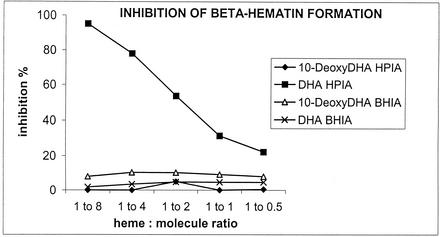The mechanism of action of artemisinin antimalarials may be ascribed to C-centered radicals that alkylate biomolecules or to the peroxide moiety, which inhibits a specific, as yet undefined, target (4). It is also proposed that artemisinins kill the parasite through inhibition of hemozoin formation, thereby allowing buildup of toxic heme monomer (1, 2, 5).
Artemisinin and dihydroartemisinin may be unstable under aqueous conditions used for hemozoin studies; ring-opened products (3) may therefore bind to the heme and inhibit hemozoin formation. 10-Deoxodihydroartemisin (Fig. 1) has no oxygen at C-10 and is less able to undergo ring opening under aqueous conditions. Therefore, even though it is an active antimalarial it may not interfere with hemozoin formation. To test this, dihydroartemisinin and 10-deoxodihydroartemisinin were screened for inhibition of β-hematin (hemozoin) formation by using both the HPIA (heme polymerization inhibitory activity) assay (2) (hematin in acetic acid at pH 2.7, 37°C, 18 h) and the BHIA (β-hematin inhibitory activity) assay (hemin in dimethyl sulfoxide-acetate buffer at pH 5.0, 37°C, 18 h). The first identifies ligands that bind axially with the protoporphyrin iron, and the second identifies ligands undergoing π-π interactions with hematin (6).
FIG. 1.
Structures of artemisinin, dihydroartemisinin, and 10-deoxodihydroartemisinin.
Dihydroartemisinin showed a dose-dependent inhibition in the HPIA assay but not in the BHIA assay. The 10-deoxy compound was inactive in both assays (Fig. 2). Thus, peroxidic antimalarials do not interfere with hemozoin formation in the parasite and are differentiated from quinoline antimalarials in that they cannot bind via π-π interactions with the heme molecule. This is also evident in their failure to inhibit β-hematin formation in the BHIA assay (6). It is uncertain if dihydroartemisinin undergoes ring opening under the HPIA assay conditions. In this case, it cannot be excluded that in the HPIA assay (pH 2.7), the ring-opened form of dihydroartemisinin will form an axial ligand with the porphyrin iron, thus inhibiting β-hematin formation. 10-Deoxodihydroartemisinin cannot easily undergo ring opening and therefore cannot bind porphyrin—it has no effect on β-hematin formation, yet it displays potent antimalarial activity.
FIG. 2.
Results of in vitro assays of inhibition of β-hematin formation. DHA, dihydroartemisinin.
Thus, inhibition of β-hematin formation in the HPIA assay by artemisinin (2) and dihydroartemisinin (this letter), but not by 10-deoxodihydroartemisinin, reflects a reactivity that is not related to their antimalarial action. Furthermore, binding of artemisinins with Fe(III)PPIX is not necessary for antimalarial activity. These data also confirm that the HPIA and BHIA assays are useful for distinguishing compounds forming π-π interactions with heme from those forming axial ligands.
REFERENCES
- 1.Asawamahasakda, W., I. Ittarat, C. C. Chang, P. McElroy, and S. R. Meshnick. 1994. Effects of antimalarials and protease inhibitors on plasmodial hemozoin production. Mol. Biochem. Parasitol. 67:183-191. [DOI] [PubMed]
- 2.Basilico, N., E. Pagani, D. Monti, P. Olliaro, and D. Taramelli. 1998. A microtitre-based method for measuring the haem polymerization inhibitory activity (HPIA) of antimalarial drugs. Antimicrob. Chemother. 42:55-60. [DOI] [PubMed] [Google Scholar]
- 3.Haynes, R. K., H.-O. Pai, and A. Voerste. 1999. Ring opening of artemisinin (qinghaosu) and dihydroartemisinin and interception of the open hydroperoxides with formation of N-oxides—a chemical model for antimalarial mode of action. Tetrahedron Lett. 40:4715-4718. [Google Scholar]
- 4.Olliaro, P. L., R. K. Haynes, B. Meunier, and Y. Yuthavong. 2001. Possible modes of action of the artemisinin-type compounds. Trends Parasitol. 17:122-126. [DOI] [PubMed] [Google Scholar]
- 5.Pandey, A. V., B. L. Tekwani, R. L. Singh, and V. S. Chauhan. 1999. Artemisinin, an endoperoxide antimalarial, disrupts the hemoglobin catabolism and heme detoxification systems in malarial parasites. J. Biol. Chem. 274:19383-19388. [DOI] [PubMed] [Google Scholar]
- 6.Parapini, S., N. Basilico, E. Pasini, T. J. Egan, P. Olliaro, D. Taramelli, and D. Monti. 2000. Standardization of the physicochemical parameters to assess in vitro the beta-hematin inhibitory activity of antimalarial drugs. Exp. Parasitol. 96:249-256. [DOI] [PubMed] [Google Scholar]




